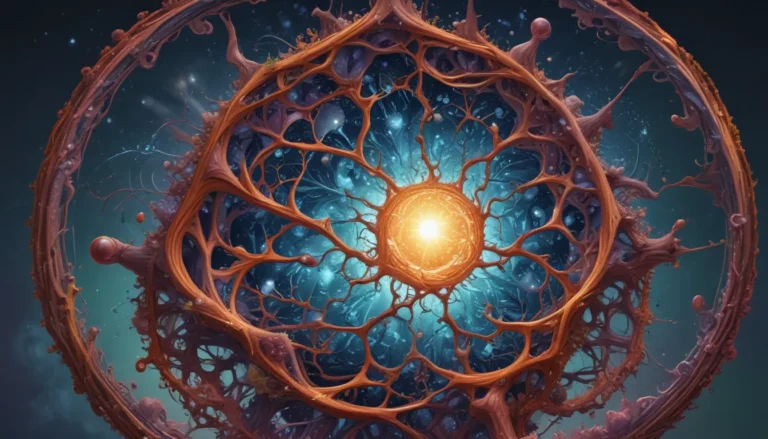A Note About Images: The images used in our articles are for illustration purposes only and may not exactly match the content. They are meant to engage readers, but the text should be relied upon for accurate information.
If you’ve ever wondered about the inner workings of cellular respiration and the powerhouse responsible for generating energy within our cells, look no further than the electron transport chain complexes. These intricate structures, nestled in the inner mitochondrial membrane, play a pivotal role in ATP synthesis, the energy currency that fuels cellular activities. While the electron transport chain complexes may seem like a complex web of proteins and processes, they hide a world of fascinating biology waiting to be explored. In this article, we’ll unravel 15 captivating facts about these remarkable complexes, shedding light on their significance and unveiling some lesser-known aspects of their functioning. Join us on this journey as we dive deep into the captivating realm of electron transport chain complexes to discover the wonders of cellular respiration.
The Vital Role of Electron Transport Chain Complexes in Cellular Respiration
At the heart of cellular respiration lies the electron transport chain, a series of protein complexes located in the inner membrane of mitochondria. These complexes are responsible for the sequential transfer of electrons and protons, ultimately leading to the generation of ATP, the essential energy currency of cells. Without the electron transport chain complexes, cells would struggle to produce the energy needed to carry out their various metabolic activities.
Unveiling the Five Major Protein Complexes Involved in the Electron Transport Chain
Within the electron transport chain, there exist five major protein complexes, each designated as complex I to complex V. These complexes work in harmony, with each playing a distinct role in the transfer of electrons and protons to facilitate the generation of ATP. From the initial electron donation to the final step of electron transfer to molecular oxygen, each complex contributes to the efficient functioning of the electron transport chain.
The Intriguing Function of Complex IV in Electron Transfer
Complex IV, also known as cytochrome c oxidase, serves a crucial role in the electron transport chain by facilitating the final step of electron transfer. This complex is responsible for transferring electrons from cytochrome c to molecular oxygen, leading to the formation of water. Without the function of Complex IV, the electron transport chain would remain incomplete, hindering ATP synthesis.
Exploring the Spatial Setting of the Electron Transport Chain
The electron transport chain unfolds its intricate dance within the inner membrane of mitochondria, providing an ideal environment for the protein complexes to carry out their functions efficiently. This impermeable membrane fosters the establishment of an electrochemical gradient by preventing the free flow of ions, which in turn drives ATP synthesis through proton movement.
The Components That Comprise Electron Transport Chain Complexes
While protein subunits form the backbone of electron transport chain complexes, non-protein components such as coenzymes and prosthetic groups play indispensable roles in electron transfer and enzymatic activity. It is the harmonious interplay of these components that allows the complexes to execute their functions with precision.
The Key Electron Carriers in the Electron Transport Chain
NADH and FADH2 emerge as pivotal players in the electron transport chain, serving as carriers of electrons that initiate the flow through the protein complexes. These electron carriers kickstart the redox reactions essential for ATP synthesis, setting the stage for a cascade of energy production within the cell.
A Symphony of Electrons and Protons in the Electron Transport Chain
As electrons traverse through the protein complexes of the electron transport chain, a simultaneous pumping of protons occurs, transferring these ions from the mitochondrial matrix to the intermembrane space. This coordinated dance of electrons and protons culminates in the creation of an electrochemical gradient critical for ATP synthesis.
The Dynamic Regulation of Electron Transport Chain Activity
The electron transport chain operates in tune with the energy needs of the cell, with ATP production exerting significant control over its speed. When ATP levels are abundant, the electron transport chain slows down to prevent an excessive proton gradient. Conversely, during periods of low ATP, the chain accelerates to bolster ATP generation.
Navigating the Terrain of Reactive Oxygen Species in Electron Transport
While the electron transport chain is vital for ATP synthesis, it also poses a potential threat in the form of reactive oxygen species (ROS) generated during electron transfer. These ROS can inflict oxidative damage on cells, but the presence of antioxidant defense systems helps mitigate their harmful effects, safeguarding cellular integrity.
Uncovering the Impact of Inhibitors on Electron Transport Chain Function
Certain substances, including drugs and toxins, have the capacity to disrupt the function of electron transport chain complexes, leading to impaired ATP synthesis and cellular dysfunction. Understanding the mechanisms of these inhibitors is crucial for maintaining the integrity of the electron transport chain.
The Significance of Oxygen in the Electron Transport Chain
Oxygen stands as the final electron acceptor in the electron transport chain, without which the entire process would come to a grinding halt, halting ATP production. This reliance on oxygen underscores the aerobic nature of the electron transport chain, emphasizing its indispensability for cellular energy generation.
The Efficiency of ATP Generation Through the Electron Transport Chain
In comparison to other metabolic pathways, the electron transport chain boasts a high energy conversion efficiency, making it a powerhouse in cellular energy production. This efficiency stems from the precise orchestration of electron transfer and proton pumping that occurs within the protein complexes.
The Susceptibility of the Electron Transport Chain to Oxidative Stress
Oxidative stress, arising from an imbalance between ROS production and the antioxidant defense system, poses a threat to the electron transport chain complexes. This stress can impair the function of the complexes, disrupting ATP synthesis and compromising cellular health.
Unraveling the Link Between Mitochondrial Diseases and Electron Transport Chain Disorders
Genetic mutations or defects in electron transport chain complexes can give rise to mitochondrial diseases, affecting various organs and tissues due to the pivotal role of mitochondria in energy production. Understanding these disorders sheds light on the intricate relationship between mitochondrial function and overall health.
The Role of Research in Shaping Our Understanding of Aging and Disease
Research focused on the electron transport chain provides valuable insights into the mechanisms underlying aging and disease development. By unraveling the intricacies of these complexes and their impact on cellular function, scientists aim to pave the way for innovative strategies to combat disease and enhance our knowledge of cellular physiology.
Conclusion: Illuminating the Wonders of Electron Transport Chain Complexes
In conclusion, electron transport chain complexes stand as marvels of cellular biology, orchestrating the intricate dance of electrons and protons to drive ATP synthesis and power cellular activities. Their indispensable role in cellular respiration underscores the significance of understanding their mechanisms and functions. By delving into the mysteries of electron transport chain complexes, we gain a deeper appreciation for the complexities of life processes and the profound impact they have on our health and well-being.
FAQs
-
What are electron transport chain complexes?
Electron transport chain complexes are protein structures located in the inner mitochondrial membrane that facilitate the transfer of electrons during cellular respiration. They are essential for the production of ATP, the energy currency in cells. -
How many electron transport chain complexes are there?
There are four main complexes in the electron transport chain: complex I (NADH dehydrogenase), complex II (succinate dehydrogenase), complex III (cytochrome bc1 complex), and complex IV (cytochrome c oxidase). -
What is the role of electron transport chain complexes in ATP synthesis?
Electron transport chain complexes help create a proton gradient across the inner mitochondrial membrane. This gradient drives ATP synthesis through the action of ATP synthase, leading to the production of ATP molecules. -
How do electron transport chain complexes function?
Electron transport chain complexes transfer electrons from electron donors, such as NADH and FADH2, to electron acceptors, such as oxygen. The electrons pass through the complexes in a series of redox reactions, releasing energy that is used to pump protons across the membrane. -
Why are electron transport chain complexes important?
Electron transport chain complexes are vital for cellular respiration and energy production. They help convert the energy stored in food molecules into ATP, which is used by cells for various biological processes.
Embark on a journey of discovery as you explore the intricacies of electron transport chain complexes and unveil the mysteries of cellular respiration. By delving into the captivating world of these vital structures, you’ll gain a newfound appreciation for the wonders of biology and the profound impact they have on our lives. Stay curious, stay inspired, and continue unraveling the secrets of life’s fundamental processes.






